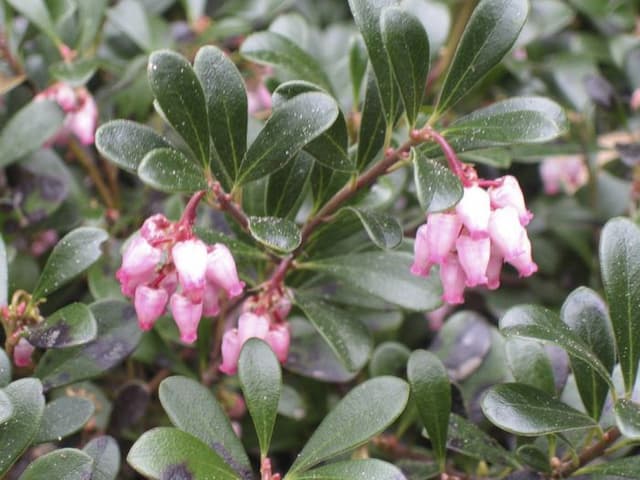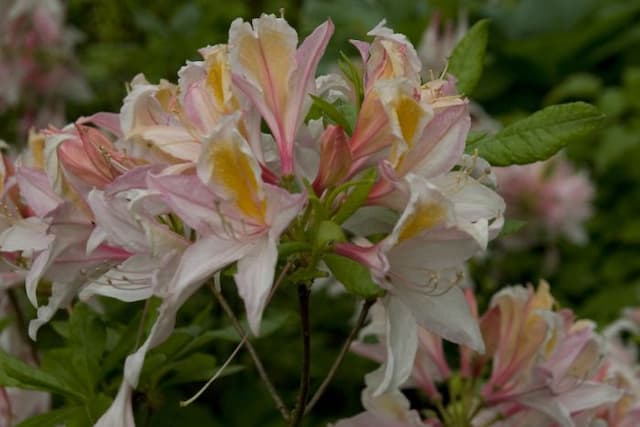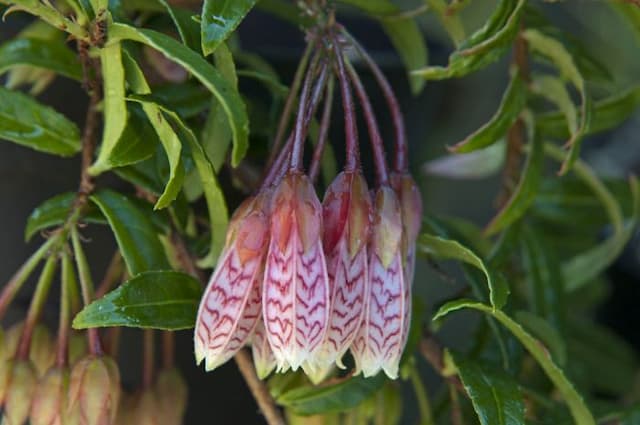Yaku Fairy Rhododendron Rhododendron keiskei var. ozawae 'Yaku Fairy'

ABOUT
The 'Yaku Fairy' is a charming variety notable for its decorative appeal and lovely blooms. This plant showcases small, elliptical leaves that are glossy and deep green, contributing to its lush, dense foliage. During the blooming season, it becomes adorned with enchanting clusters of flowers that possess a delicate, funnel shape. These blossoms are typically a soft pink to white color, often with subtle speckling or shading that adds to their beauty. Displaying a neat, mounded shape, the 'Yaku Fairy' presents an overall appearance that is both tidy and attractive, making it a favorite among garden enthusiasts for its endearing aesthetic qualities.
About this plant
 Names
NamesSynonyms
Yaku Fairy Rhododendron, Ozawa's Rhododendron
Common names
Rhododendron keiskei var. ozawae.
 Toxicity
ToxicityTo humans
Rhododendron, including the Rhododendron keiskei var. ozawae 'Yaku Fairy', is known to be toxic to humans if ingested. The plant contains grayanotoxins, which can affect the skeletal and cardiac muscles, as well as blood pressure. Symptoms of rhododendron poisoning can include nausea, vomiting, drooling, diarrhea, lethargy, weakness, abdominal pain, low blood pressure, and potentially heart rhythm disturbances. In severe cases, it could result in coma or death.
To pets
Rhododendron is also toxic to pets such as dogs, cats, and horses. The plant contains grayanotoxins that can lead to symptoms like vomiting, drooling, diarrhea, weakness, and loss of appetite in pets. In severe cases, ingestion can cause a drop in blood pressure, abnormal heart rate and rhythms, and even potentially lead to coma or death if the quantity ingested is large enough.
 Characteristics
CharacteristicsLife cycle
Perennials
Foliage type
Evergreen
Color of leaves
Green
Flower color
White
Height
2 feet (0.61 meters)
Spread
2 feet (0.61 meters)
Plant type
Shrub
Hardiness zones
6
Native area
Japan
Benefits
 General Benefits
General Benefits- Ornamental Value: 'Yaku Fairy' Rhododendron is highly sought for its aesthetic appeal due to its compact growth habit and beautiful pale pink to white flowers that bloom in spring.
- Landscape Versatility: This plant is suitable for various garden settings, including rock gardens, woodland areas, and as a border or foundation plant, thanks to its small size and attractive foliage.
- Pollinator Attraction: The blooms of the 'Yaku Fairy' Rhododendron attract butterflies and other pollinators, supporting local ecosystems and promoting biodiversity.
- Low Maintenance: Once established, the 'Yaku Fairy' Rhododendron requires relatively low maintenance, making it a convenient choice for busy gardeners.
- Hardiness: 'Yaku Fairy' Rhododendron is tolerant of cold temperatures, making it a resilient choice for cooler climates.
- Year-Round Interest: With its evergreen leaves, the 'Yaku Fairy' Rhododendron provides visual interest throughout all seasons, not just when in bloom.
- Soil Tolerance: This plant is adaptable to a range of soil conditions, provided they are well-drained and slightly acidic.
 Medical Properties
Medical PropertiesThis plant is not used for medical purposes.
 Air-purifying Qualities
Air-purifying QualitiesThis plant is not specifically known for air purifying qualities.
 Other Uses
Other Uses- Photography subjects: The lush blooms of Yaku Fairy are often used by photographers to practice macro photography and capture the beauty of nature.
- Miniature gardens: Because of its small size, Yaku Fairy rhododendrons are ideal for creating beautiful miniature gardens and fairy-themed landscapes.
- Bonsai: Enthusiasts may use this rhododendron for bonsai, as its small leaves and flowers can complement the bonsai aesthetic well.
- Educational tool: Schools and educational programs might use the plant to teach students about botany and the life cycle of plants.
- Floral art: Its unique flowers can be used in floral art arrangements, where their compact size can be used to complement larger blooms.
- Wedding decor: Given their charm, they might be included as part of wedding decorations, especially for spring or garden-themed weddings.
- Gift plants: Yaku Fairy rhododendrons can be given as a thoughtful gift to plant enthusiasts or anyone who appreciates their delicate beauty.
- Therapeutic horticulture: The care of Yaku Fairy plants can be used in horticultural therapy programs to improve mental health and wellbeing.
- Color palettes: Artists and designers may look to the Yaku Fairy’s blooms as inspiration for color palettes in their work.
- Culinary decoration: Although not recommended for consumption, petals may occasionally adorn plates for visual appeal in upscale dining experiences.
Interesting Facts
 Feng Shui
Feng ShuiThe Rhododendron is not used in Feng Shui practice.
 Zodiac Sign Compitability
Zodiac Sign CompitabilityThe Rhododendron is not used in astrology practice.
 Plant Symbolism
Plant Symbolism- Caution or Danger: Rhododendrons are often a symbol of caution or danger due to certain species containing toxic substances that can be harmful when ingested.
- Beware: Similar to caution or danger, rhododendrons can represent a warning to beware, possibly due to the toxicity of the plant.
- Elegance and Wealth: Due to their lush and beautiful appearance, rhododendrons can symbolize elegance and wealth, as they are often associated with opulent gardens and estates.
- Passion: Some rhododendron species have red flowers, which can be associated with passion and strong emotions.
- Temporality: Rhododendrons have a short blooming period, symbolizing the transient nature of life and the importance of living in the moment.
 Water
WaterThe Yaku Fairy Rhododendron requires consistent moisture and should be watered thoroughly about once a week, although this may vary with climate conditions. During dry periods, especially in the growing season, the plant may need water twice a week. Use 1 to 1.5 gallons of water each time to ensure the soil is moist but not waterlogged. During the winter, reduce watering but do not allow the soil to completely dry out. Make sure to water the plant at its base to avoid wetting the foliage, which can lead to fungal diseases.
 Light
LightThe Yaku Fairy Rhododendron prefers dappled sunlight or partial shade, thriving well under the canopy of larger trees that provide filtered light. Direct sunlight can damage its delicate leaves, especially in hotter climates. The ideal spot would provide morning sunlight and afternoon shade, ensuring the plant gets light without being exposed to the intense midday sun.
 Temperature
TemperatureThe Yaku Fairy Rhododendron is cold-hardy and prefers an environment with temperatures ranging between 40 to 75 degrees Fahrenheit. It can withstand occasional dips down to about 10 degrees Fahrenheit but should be protected from harsh winter winds. Keep it away from extreme heat as temperatures consistently above 80 degrees Fahrenheit can stress the plant.
 Pruning
PruningThe Yaku Fairy Rhododendron benefits from light pruning to remove dead flowers and maintain shape. Prune immediately after flowering to ensure that the plant's energy goes into growth instead of seed production. Occasional removal of wayward branches can be done to keep a compact form, but heavy pruning is rarely needed.
 Cleaning
CleaningAs needed
 Soil
SoilYaku Fairy Rhododendrons require acidic, well-draining soil with a pH of 4.5 to 6.0. A mix of 50% peat moss, 30% pine bark, and 20% perlite or coarse sand is ideal to ensure proper drainage and aeration.
 Repotting
RepottingYaku Fairy Rhododendrons should be repotted every 2 to 3 years or when they outgrow their current container, using a similar acidic soil mix as mentioned above.
 Humidity & Misting
Humidity & MistingYaku Fairy Rhododendrons thrive in moderate to high humidity levels, typically between 40% and 60%, which mimics their natural mountainous and forest habitats.
 Suitable locations
Suitable locationsIndoor
Place Yaku Fairy in bright, indirect light with acidic soil mix and high humidity.
Outdoor
Plant Yaku Fairy in partial shade with acidic, well-draining soil, and protect from harsh sun.
Hardiness zone
5-8 USDA.
 Life cycle
Life cycleRhododendron keiskei var. ozawae 'Yaku Fairy', commonly known as Rhododendron 'Yaku Fairy', begins its life as a seed that requires well-drained, acidic soil to germinate. Once the seedling emerges, it goes through a period of vegetative growth, developing a woody stem and evergreen leaves that can survive in partial shade to full sun. As it matures, the plant enters a reproductive phase, typically marked by the blooming of attractive flowers, varying from white to pink, in the spring. After pollination, typically by insects, the flowers develop into seed capsules that eventually release seeds, completing the reproduction cycle. In optimal conditions, a single Rhododendron 'Yaku Fairy' can live for several decades, growing slowly and maintaining a compact form. Seasonal changes will see the plant undergo periods of dormancy, typically in colder months, followed by a resurgence of growth and flowering in the spring.
 Propogation
PropogationPropogation time
Spring-Early Summer
Rhododendron keiskei var. ozawae 'Yaku Fairy', commonly known as "Yaku Fairy Rhododendron," is typically propagated by cuttings. The best time to take cuttings is during the late spring to early summer when new growth is semi-hard, meaning it is not too soft and not fully hardened. Cuttings should be about 3 to 5 inches (approximately 7.6 to 12.7 centimeters) in length and include a few leaves for photosynthesis. The cut end of the cutting is often dipped in rooting hormone to encourage root growth and then inserted into a well-draining soil mix. The soil should be kept moist but not waterlogged, and the cutting should be placed in bright, indirect light until roots have established, which can take several weeks. Once the roots have formed, the new plant can be transplanted to a more permanent location.









